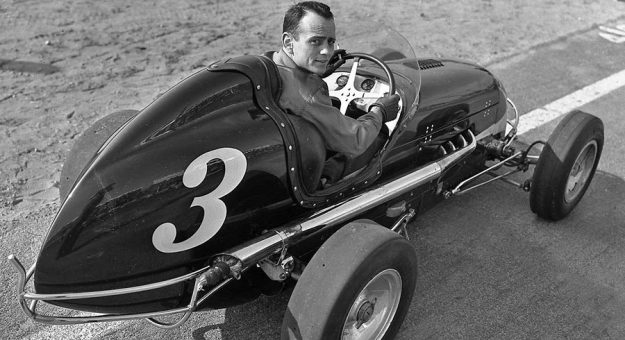The wounded soldier, shrapnel in his body, lay painfully in the German field hospital after his unit’s wooden invasion glider was shot down near the Dutch border.
Incredibly, the German physician thought he recognized his charge, part of the U.S. Army’s elite 82nd Airborne Division. According to the soldier, Phil Walters, the military doctor peered at him and abruptly asked, in accented English:
“What’s Ted Tappett doing in my hospital?”
According to New York motorsports historian Bill Green, who says Walters told him the story himself, the doctor had attended medical school in Philadelphia and in his off hours watched midget racing at the city’s Yellow Jacket Stadium, where Walters was a top competitor under the pseudonym, Ted Tappett, which he’d adopted before the war to conceal his dangerous hobby from his mother.
The doctor got a Luftwaffe pilot from a nearby base who had also raced automobiles to donate life-saving blood to Walters, who had lost a lung and kidney.
Under his early moniker, Walters became a top midget competitor, winning races all around the Northeast and becoming a star of the American Racing Drivers Club. As Tappett, he was also a significant winner in stock cars as they began to displace the costly midgets after the war.
That led, circuitously, to a meeting with American sportsman Briggs Swift Cunningham and eventually, to a lead spot on his sports car team as it fought quixotically to conquer the 24 Hours of Le Mans.
A quiet, gentle individual and self-taught pianist, Walters witnessed hideous carnage, on the speedways and otherwise. When 83 spectators were mowed down in the Le Mans catastrophe of 1955, Walters walked away from the sport and never returned.
At the time, he had a standing offer from Enzo Ferrari to join Maranello’s team in Formula 1. If Walters — by this time, his nom de guerre was long retired — had stayed in the cockpit, his name would likely command the same instant recognition and reverence today as that of Phil Hill, Carroll Shelby and even Dan Gurney, who as a youngster had watched him win in midgets while holding a “TAPPETT” sign.
“At the time, he had four kids, including me, and my mother was worried because over the years, he had known so many men who died,” his daughter Linda Walters-Grimes said recently. “He quit at the end of that race.”
If judged only by his background, Walters was the unlikeliest of racing heroes. Born in New York City in 1916, he spent his childhood in China, where his father was assigned as a Standard Oil executive until Walters was 13. Returning stateside, the Walters family settled in Manhasset, located in Nassau County just east of the city, and where Gurney was then living as a toddler.
By some accounts, Walters became immersed in another toddling enterprise, the early Long Island hot rod scene, which in turn led him to gravitate to the bullring at Freeport Stadium on the island’s south shore.
By this time, in 1938, Walters owned a helmet. He toted it to Freeport and convinced midget owner Gus Ermish, who had just cashiered his driver, that he was Ted Tappett, a gunfighter from California establishing himself in the East. Walters finished first in the consolation, his first time in an actual race car. He later admitted his introduction was concocted. Ermish didn’t care and instead bought a new Pop Dreyer car for Walters, as Tappett, to campaign.
The 1939 season firmly established Tappett as a midget star, with 11 wins and another 11 runner-up finishes in 45 starts, as midgets battled seven nights a week across the Northeast. The following year, Tappett captured 26 consecutive features. In 1941, Walters started 46 midget features and never placed worse than third. The ARDC had been formed, with the one-legged Long Island hot shoe Bill Schindler as its first president.
Walters made it to California for real as a member of the Mike Caruso team, whose talent had variously included Schindler, Henry Banks and Mike Nazaruk.
Click below to continue reading.
